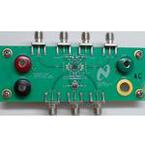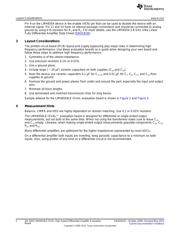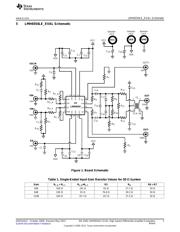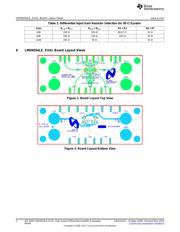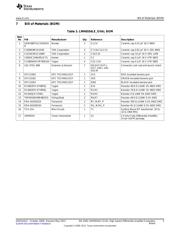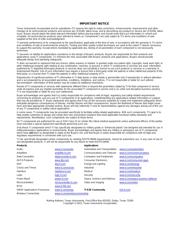下载

User's Guide
SNOA541C–October 2009–Revised May 2013
AN-1945 LMH6554LE-EVAL High Speed Differential
Amplifier Evaluation Board
1 General Description
The LMH6554LE−EVAL evaluation board is designed to aid in the characterization of Texas Instruments
LMH6554 fully differential amplifier in an 14 lead UQFN package. The LMH6554 is part of the LMH™
high-speed amplifier family.
Use the evaluation board as a guide for high frequency layout and as a tool to aid in device testing and
characterization.
The evaluation board schematic is shown in Figure 1. For recommended for component values, see the
device-specific data sheets.
2 Basic Operation
The LMH6554LE−EVAL evaluation board has been set up to provide maximum flexibility for evaluating
TI’s differential LMH6554 operational amplifier. The board supports fully differential operation as well as
single-ended to differential and single-ended to single-ended operation. For fully differential operation, use
resistors R
2
and R
3
to set the input impedance of the amplifier. The differential input resistance will be
equal to 2*R
2
|| 2*R
G_M
. Where R
2
= R
3
and R
G_M
= R
G_P
. In this mode resistors R
G_M
, R
G_F
, R
F_M
and R
F_P
set the gain of the amplifier. Amplifier gain = R
F_M
/R
G_M
= R
F_P
/R
G_P
where R
G_M
= R
G_P
and R
F_M
= R
F_P
. For
more details on gain component value selections, see Table 2. For single-ended input mode of operation,
the input and termination resistance must be properly configured to give the correct gain and input
impedance (R
IN
). For example, in the case of the LMH6554, if a gain of 2 V/V is desired, R
2
= R
3
= 76.8 Ω,
R
G_M
= R
G_P
= 90 Ω, R
F_M
= R
F_P
= 200 Ω, C
2
and R
14
= OPEN, C
3
= 0.1 µF, and R
15
= 50 Ω, which will
make R
IN
= 50 Ω at the most positive node of R
3
looking into R
G_M
. Further details of single-ended input
mode calculations can be found in the LMH6554 2.8 GHz Ultra Linear Fully Differential Amplifier Data
Sheet (SNOSB30). Components C
3
= 0.1 µF and R
15
= 50 Ω should be used to AC-couple and balance the
inputs, otherwise can be left empty. In this example the input signal would be connected to the VIN- input.
For more details on gain component value selections, see Table 1.
For differential output applications, load R
6
and R
7
with the desired values to match the output load and
leave C
14
and C
15
empty. Typically to match a test equipment, R
6
= R
7
= 50 Ω.
If single-ended output is desired an output transformer such as the TC4-19 from mini circuits can be
utilized. The TC4-19 has a 4:1 impedance ratio (2:1 turns/voltage ratio). This is particularly useful for
interfacing to a 50 Ω test equipment. When referencing the transformer data sheet, the
LMH6554LE−EVAL evaluation board has the primary windings on the output side of the evaluation board
and the amplifier is driving the secondary windings. This provides a step down transformation from the
differential amplifier output to the test equipment. The center-tapped secondary winding also allows a
differential to single ended conversion (Balun). The impedance seen by the differential amplifier = (R
6
+ R
7
+ R
L
*4), where R
L
is the impedance from pin 4 of the transformer to the load. For example, if R
L
= 50 Ω for
the test equipment, to achieve an impedance of 500 Ω seen by the LMH6554 differential output R
6
= R
7
=
150 Ω with C
14
= C
15
= R
12
= R
13
= 0 Ω. The LMH6554LE−EVAL board is equipped with pads to add
additional filtering schemes using C
14
- C
18
and R
8
- R
13
.
LMH, LMH6554LE−EVAL are trademarks of Texas Instruments.
All other trademarks are the property of their respective owners.
1
SNOA541C–October 2009–Revised May 2013 AN-1945 LMH6554LE-EVAL High Speed Differential Amplifier Evaluation
Board
Submit Documentation Feedback
Copyright © 2009–2013, Texas Instruments Incorporated

